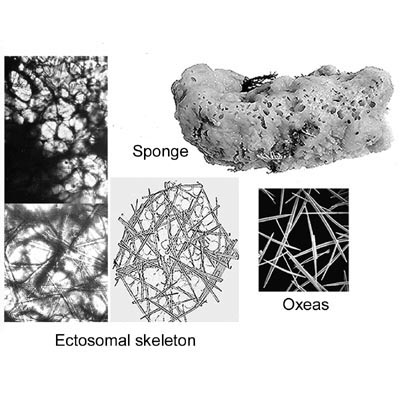[A]
COMPARISON BETWEEN THE TWO SPECIES |
 (Pallas, 1766)
(Pallas, 1766) |
Spicules: Megascleres:
(1) Oxeas:
160 -313- 420 um.
x 1 -5- 12 um.
Warning: Undefined array key 4 in /home/thackerdb2/public_html/casponges/programfiles/WCS_Key4.php on line 129
Warning: Undefined array key 1 in /home/thackerdb2/public_html/casponges/programfiles/WCS_Key4.php on line 131
(1) Surface opaque.
(2) Ectosomal skeleton with regular loose reticulation of multispicular tracts.Pores closely spaced between the tracts.
(3) Tangential skeleton not easily removed.
(4) Sponge typically encrusting with oscules on ridges but may also have tube-like oscules or anastomosing hollow branches with oscules at the tip.
(5) Oscules obvious.
(6) Color. Choanosome yellow; Ectosome in light, greenish.
Note:This species is most often found on the open coast. It may intrude into bays where salinity and current regimes approximate those of the outer coast regimes. In bay localities this species tends to form branches similar to those of H. bowerbanki. No single character can unequivocally separate these two species. All must be reviewed.
|
|
[B]
COMPARISON BETWEEN THE TWO SPECIES
|
 Burton, 1930
Burton, 1930 |
Spicules: Megascleres:
Warning: Undefined array key 1 in /home/thackerdb2/public_html/casponges/programfiles/WCS_Key4.php on line 325
(1) Oxeas:
170 - 300 um.
x 5.0 - 12.0 um.
Warning: Undefined array key 4 in /home/thackerdb2/public_html/casponges/programfiles/WCS_Key4.php on line 342
Warning: Undefined array key 1 in /home/thackerdb2/public_html/casponges/programfiles/WCS_Key4.php on line 345
(1) Surface translucent or nearly so.
(2) Ectosomal skeleton with widly spaced more or less parallel multispicular tracts.
(3) Tangential skeleton easily removed.
(4) Sponge typically encrusting with branches. Branches often flattened lobes with somewhat serrated edges or round, raised tubes.
(5) Oscules not obvious.
(6)Color.Choanosome orange-yellow; ectosome light orange-yellow.
Note:This species is found in bay localities. However, under certain conditions this species takes on some of the features of H. panicea. These include a more strictly encrusting form with little or no branching. These two species are often difficult to distinguish. This may be exacerbated by the possibility that we may have a few additional "sister" species that could be confused with these two common Halichondriids.
|
|